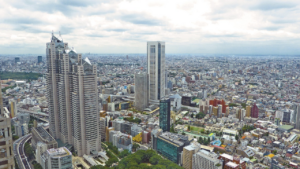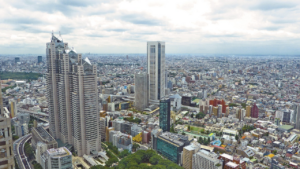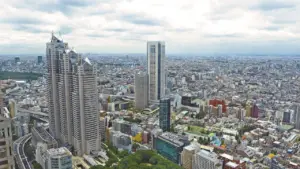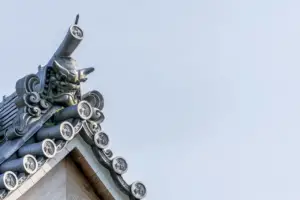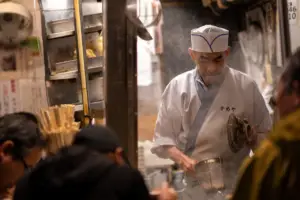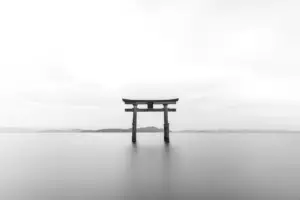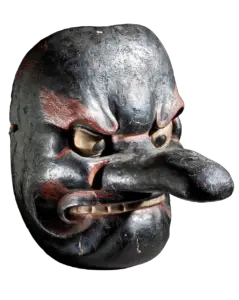Are you ready to witness the ancient tradition of Sumo wrestling? Tokyo, the bustling capital city of Japan, is the perfect place to experience this cultural phenomenon. Sumo wrestling has been a part of Japanese history for centuries and is deeply rooted in tradition and ritual.
As a spectator, you will not only witness the strength and athleticism of the wrestlers, but also the customs and etiquette that surround this revered sport.
In this guide, we will provide you with all the information you need to fully immerse yourself in the world of Sumo wrestling. From the history and rules of the sport, to the famous wrestlers and tournaments in Tokyo, we will cover it all.
We will also share tips on how to best enjoy the experience, from navigating the arena to understanding the atmosphere. Get ready to witness the power and grace of Sumo wrestling, and gain a deeper appreciation for the traditions of Japan.
Key Takeaways
- Sumo wrestling is deeply rooted in tradition and ritual, and has been a part of Japanese history for centuries.
- To win a match, a wrestler must force their opponent out of the ring or make any part of their opponent’s body touch the ground besides the soles of their feet.
- Sumo wrestlers undergo a strict regimen of training, including morning practice and afternoon training sessions, and have a unique lifestyle and strict diet.
- Witnessing sumo wrestling is a celebration of Japanese culture and history, and visitors can experience the rigorous training regimen and strict diet of the wrestlers by visiting a sumo stable.
History of Sumo Wrestling in Japan
You’ll be fascinated to learn about the rich history of sumo wrestling in Japan, tracing back to ancient rituals and customs that still influence the sport today.
The origins of sumo wrestling can be traced back to Shinto religious traditions, where it was believed that wrestling matches could appease the gods and bring good harvests.
These early forms of sumo wrestling were more like rituals than sport, with wrestlers often wearing loincloths and performing chants and prayers before matches.
Over time, sumo became more organized and competitive. The first professional sumo tournaments were held in the 1600s, with wrestlers competing for prizes and prestige.
Sumo wrestling became a popular form of entertainment in Japan, and today, it is one of the country’s most beloved sports.
Despite its evolution over the centuries, sumo wrestling has maintained its traditional elements, including the use of ritualistic gestures and the importance placed on respecting one’s opponent.
Rules and Regulations of Sumo Wrestling
Now that you’ve learned about the rich history of sumo wrestling in Japan, it’s time to dive into the rules and regulations of this ancient sport.
Two key points to understand are Scoring and Winning, and Techniques and Strategies. These aspects of sumo wrestling are essential for any spectator to fully appreciate the skill and athleticism of the wrestlers.
So, get ready to learn and be amazed by the intricate rules and techniques that make sumo wrestling such an exciting and unique sport.
Scoring and Winning
To win a sumo wrestling match, a wrestler must either force their opponent out of the ring or make any part of their opponent’s body touch the ground besides the soles of their feet. It’s a simple concept, but executing it is another story. Sumo wrestlers employ various techniques and strategies to try and outmaneuver their opponent.
Here are some of the most common ways a wrestler can score a win:
-
Yorikiri: This is when a wrestler forces their opponent out of the ring by pushing them backwards.
-
Tsukidashi: A wrestler wins by pushing their opponent out of the ring, but this time they do it by thrusting them out.
-
Oshidashi: This is when a wrestler wins by pushing their opponent out of the ring, but they do it by putting their hands on their opponent’s body and using their strength to push them out.
In sumo wrestling, it’s not just about brute strength – technique and strategy play a huge role in determining the outcome of a match. By understanding the various ways a wrestler can score a win, you’ll be able to appreciate the sport even more. So next time you watch a sumo match, keep an eye out for these techniques and see if you can predict who’ll come out on top.
Techniques and Strategies
If you’re a fan of sumo wrestling, understanding the various techniques and strategies used by wrestlers can make watching matches even more enjoyable.
One of the most common techniques used by wrestlers is the tsuppari, which involves a series of quick, sharp slaps to the opponent’s chest or face. This technique is used to disrupt the opponent’s balance and throw them off balance.
Another popular technique is the yotsu-zumo, which involves grappling and holding onto the opponent’s mawashi, or loincloth. There are two main variations of this technique: the migi-yotsu, which involves holding onto the opponent’s mawashi with your right hand, and the hidari-yotsu, which involves holding onto the opponent’s mawashi with your left hand.
Wrestlers will then try to use their size and strength to push their opponent out of the ring or force them to touch the ground with any part of their body other than their feet.
Understanding these techniques and strategies can help you appreciate the skill and athleticism of sumo wrestlers even more.
Sumo Wrestling Tournaments in Tokyo
You’ll witness the excitement of Sumo Wrestling Tournaments in Tokyo as the wrestlers clad in loincloths and topknots fiercely compete in the ring. These tournaments, known as basho, take place six times a year in Tokyo’s Ryogoku Kokugikan, which is also the home of the sumo museum. The tournaments last for fifteen days and feature six divisions of wrestlers battling it out for the championship title.
Each day of the tournament is filled with intense matches, with the highest ranked wrestlers competing towards the end of the day. The excitement builds as the wrestlers enter the ring and perform their pre-match rituals, which include throwing salt to purify the ring and stomping their feet to intimidate their opponent. If you’re lucky enough to attend a tournament, make sure to check out the schedule and plan your visit accordingly. Here’s a table to help you plan your trip:
| Tournament Dates | Venue |
|---|---|
| January | Ryogoku Kokugikan |
| March | Ryogoku Kokugikan |
| May | Ryogoku Kokugikan |
| July | Ryogoku Kokugikan |
| September | Ryogoku Kokugikan |
| November | Ryogoku Kokugikan |
Don’t miss out on the opportunity to witness this ancient tradition in action. The tournaments are not only a display of incredible athleticism, but also a celebration of Japanese culture and history. Get your tickets early and experience the thrill of sumo wrestling for yourself.
Famous Sumo Wrestlers in Tokyo
So, you wanna know about the famous sumo wrestlers in Tokyo? Well, get ready to dive into some fascinating profiles of the top wrestlers, including their achievements, fighting styles, and signature moves.
But it’s not just about the matches – we’ll also explore the intense training and unique lifestyle of sumo wrestlers. From their strict diets to their daily routines.
Are you ready to learn about the world of sumo wrestling from the inside out? Let’s go!
Profiles of Top Wrestlers
Get ready to be awed by the sheer strength and skill of the top sumo wrestlers in Tokyo. Their profiles are a testament to the intense dedication and discipline required to excel in this ancient sport. Here are four of the most impressive sumo wrestlers to watch out for:
-
Hakuho Sho: With a record-breaking 44 championships under his belt, Hakuho Sho is widely considered to be the greatest sumo wrestler of all time. He’s known for his impeccable technique, lightning-fast reflexes, and unmatched physical strength.
-
Kakuryu Rikisaburo: Kakuryu Rikisaburo is a force to be reckoned with in the sumo world. He’s won six championships throughout his career and is known for his impressive agility and strategic approach to matches.
-
Asanoyama Hideki: Asanoyama Hideki is a rising star in the sumo world, having won his first championship in 2019. He’s known for his powerful tachi-ai (initial charge) and his ability to quickly overpower his opponents.
-
Terunofuji Haruo: Terunofuji Haruo is a comeback story in the sumo world. He struggled with injuries and setbacks before making a triumphant return in 2021, winning his second championship. He’s known for his impressive size and strength, as well as his perseverance and determination.
Watching these top sumo wrestlers in action is truly a sight to behold. Each wrestler brings their own unique style and approach to the ring, from Hakuho Sho’s flawless technique to Terunofuji Haruo’s incredible strength. Don’t miss your chance to witness the tradition and skill of these incredible athletes during your visit to Tokyo.
Training and Lifestyle of Sumo Wrestlers
The rigorous training and unique lifestyle of sumo wrestlers require immense discipline and dedication. Sumo wrestlers undergo a strict regimen of training, starting as early as 5:00 am with a morning practice or "asa-geiko". This involves practicing various techniques and exercises to improve their strength, agility, and flexibility. After a quick breakfast, they rest and nap until lunchtime.
The afternoon is reserved for further training, with wrestlers practicing against each other in "keiko"sessions. These sessions can last for hours, with wrestlers taking breaks in between to hydrate and rest. The lifestyle of sumo wrestlers is also unique, with wrestlers living and training together in "stables"or "heya". They follow a strict diet, consisting mainly of chanko-nabe, a stew made with meat, vegetables, and tofu, to maintain their size and weight.
| Training Techniques | Training Schedule | Diet |
|---|---|---|
| Shiko | Early morning practice | Chanko-nabe stew |
| Teppo | Afternoon practice | Protein-rich foods |
| Yotsu-zumo | Intense keiko sessions | Low-fat, high-carb meals |
| Yotsu-zumo | Rest and nap time | Moderate alcohol consumption |
| Kawaigari | Daily sparring sessions | Limited sugar intake |
As you can see, the training and lifestyle of sumo wrestlers are structured and demanding. Each aspect is tailored to maximize their physical and mental strength, as well as their overall health. It takes years of dedication and discipline to become a successful sumo wrestler, but witnessing their matches and traditions is a truly unforgettable experience.
Etiquette and Customs at Sumo Wrestling Tournaments
When attending a sumo wrestling tournament, it’s important to adhere to the dress code and behavior guidelines.
Remember to dress modestly and respectfully, as this is a cultural event.
Additionally, be sure to follow the food and drink traditions.
For example, don’t eat or drink while the wrestlers are in the ring.
By respecting these customs, you can fully immerse yourself in the experience and show your appreciation for this ancient Japanese tradition.
Dress Code and Behavior
To fully immerse yourself in the tradition of sumo wrestling in Tokyo, it’s essential that you adhere to the proper dress code and exhibit respectful behavior throughout the event. Here are some tips on what to wear and how to behave:
-
Dress conservatively: Avoid wearing revealing or flashy clothing. Men should wear a shirt and pants, while women should opt for a dress or skirt that covers the knees, along with a modest top.
-
Remove your shoes: Before entering the arena, you’ll need to take off your shoes and place them in a designated area. Make sure to wear clean socks or bring a spare pair.
-
Turn off your phone: It’s considered rude to use your phone during the tournament, so make sure to turn it off or put it on silent.
-
Sit quietly and respectfully: The atmosphere at sumo matches is serious and respectful. Avoid talking loudly or making sudden movements that could distract the wrestlers.
-
Show appreciation for the wrestlers: At the end of each match, the winner will perform a victory ceremony. Show your appreciation by clapping and cheering respectfully.
Following these guidelines will help you fully appreciate the tradition and culture of sumo wrestling in Tokyo. Remember to be respectful and enjoy the experience!
Food and Drink Traditions
You’ll love experiencing the unique food and drink traditions that accompany a sumo match in Tokyo. The atmosphere is electric and the food is delicious, making it an unforgettable experience. Here are some of the food and drink options you can expect to find at a sumo match in Tokyo:
| Food | Description |
|---|---|
| Chanko-nabe | A hearty hot pot dish filled with vegetables, meat, and seafood, traditionally eaten by sumo wrestlers to gain weight and muscle. |
| Yakitori | Grilled skewers of meat or vegetables, perfect for snacking on throughout the match. |
| Asahi Super Dry | The official beer sponsor of the Japan Sumo Association, this crispy and refreshing beer pairs perfectly with the savory food options. |
Make sure to arrive at the match with an empty stomach, as the food options are endless. And don’t forget to try the chanko-nabe, a sumo wrestler favorite that is not to be missed. Cheers to a fantastic match!
The Arena and Atmosphere of Sumo Wrestling
Experience the electrifying atmosphere of the sumo wrestling arena, where the cheers of the crowd and the intensity of the matches will leave you on the edge of your seat.
The arena, called a ‘dohyo,’ is a raised platform made of clay and covered with sand. It is surrounded by cushions for the wrestlers to fall on and a ring of straw bales, called ‘tawara,’ to mark the boundary.
As you enter the arena, the first thing you’ll notice is the aroma of salt in the air. Before each match, the wrestlers perform a ritual called ‘shiko’ where they stomp their feet and throw salt to purify the dohyo and ward off evil spirits.
The crowd, dressed in traditional attire, is lively and enthusiastic, shouting the wrestlers’ names and throwing their hands up in excitement.
The matches themselves are quick and intense, with the wrestlers pushing and shoving each other until one is pushed outside the boundary or touches the ground with any part of their body other than their feet.
The atmosphere is truly unforgettable and a must-see experience for anyone visiting Tokyo.
Sumo Wrestling Outside of Tournaments
Now that you’ve got a good idea of what it’s like to be inside a sumo arena during a tournament, let’s talk about experiencing sumo wrestling outside of official matches.
One popular option is to visit a sumo stable, which is essentially a training facility for professional sumo wrestlers. Here, you’ll get a behind-the-scenes look at how these athletes prepare for their matches, including their rigorous training regimen and strict diet. It’s a fascinating experience that can give you a deeper appreciation for the dedication and discipline that goes into becoming a sumo wrestler.
Feel the intensity of the wrestlers’ training as they push themselves to the limit. Smell the traditional Japanese cuisine that is carefully prepared to meet the strict dietary requirements of sumo wrestlers. Hear the sounds of grunting and stomping as the wrestlers practice their moves and techniques. See the incredible physical strength and agility of these athletes up close and personal.
Whether you choose to attend a tournament or visit a sumo stable, there’s no denying the raw power and beauty of sumo wrestling. It’s a sport that has captivated audiences for centuries, and one that continues to inspire and awe to this day.
Tips for Enjoying Sumo Wrestling in Tokyo
If you want to enjoy sumo wrestling in Tokyo, you need to plan ahead for transportation and accommodation. The best way to get to the stadium is by taking the train or subway, and it’s recommended to stay nearby to avoid the crowds.
As for souvenirs and memorabilia, there are plenty of options available at the stadium and nearby shops, so make sure to grab something to remember your experience.
Don’t miss out on the chance to witness this amazing tradition firsthand!
Transportation and Accommodation
To fully immerse yourself in Tokyo’s sumo wrestling culture, you’ll need to secure transportation and accommodation beforehand. The city has an efficient public transportation system that can take you to the different sumo venues around Tokyo.
The closest station to the Ryogoku Kokugikan, the main sumo stadium, is Ryogoku Station on the JR Sobu Line. You can also take the Toei Oedo Line and get off at the Ryogoku Station. Other sumo venues include the Tokyo Metropolitan Gymnasium, which is accessible through Sendagaya Station on the JR Chuo-Sobu Line or Kokuritsu-Kyogijo Station on the Toei Oedo Line.
When it comes to accommodation, you can choose from a range of options depending on your budget and preferences. If you want to stay near the sumo venues, there are several hotels and guesthouses in the Ryogoku area. However, these tend to be more expensive than accommodations in other parts of Tokyo.
Alternatively, you can stay in other areas of Tokyo and take advantage of the city’s excellent transportation system to get to the sumo venues. Some popular areas to stay in include Shinjuku, Shibuya, and Asakusa. Whichever option you choose, make sure to book your transportation and accommodation well in advance to avoid any last-minute hassles.
Souvenirs and Memorabilia
Don’t forget to pick up some souvenirs and memorabilia to bring back home with you as a reminder of your unforgettable experience at the sumo matches in Tokyo. There are plenty of options available, from t-shirts and keychains to more traditional items like woodblock prints and ceramic figurines. The best place to find these items is at the Kokugikan arena, where the sumo tournaments take place. The arena has a large gift shop with a variety of sumo-related merchandise. You can also find vendors selling souvenirs outside of the arena, but be aware that the prices may be higher than inside the gift shop.
To give you an idea of the types of souvenirs and memorabilia available, here’s a table showcasing some of the most popular items:
| Item | Description | Price Range |
|---|---|---|
| T-shirt | A cotton t-shirt with a sumo wrestler design | ¥1,500-¥3,000 |
| Ceramic figurine | A small, hand-painted figurine of a sumo wrestler | ¥2,000-¥5,000 |
| Woodblock print | A traditional Japanese print featuring sumo wrestlers | ¥3,000-¥7,000 |
| Keychain | A miniature sumo wrestler attached to a keychain | ¥500-¥1,000 |
| Towel | A cotton towel with a sumo wrestler design | ¥1,000-¥2,000 |
As you can see, there’s something for every budget and taste. Make sure to budget some extra money for souvenirs, as they make great gifts for friends and family back home. You’ll cherish these items as reminders of your incredible experience witnessing the tradition of sumo wrestling in Tokyo.
Frequently Asked Questions
How long does it take to become a professional sumo wrestler in Japan?
Becoming a professional sumo wrestler in Japan is no small feat. It takes years of rigorous training and dedication to the sport.
On average, it can take anywhere from 5 to 10 years to reach the professional level. However, this timeline can vary greatly depending on the individual’s talent, physical ability, and work ethic.
To become a professional sumo wrestler, one must first join a stable and begin training as a rikishi. From there, they must work their way up the ranks through various tournaments and matches, constantly improving their skills and technique.
It’s a tough and demanding process, but for those who are passionate about the sport, the reward of becoming a professional sumo wrestler is well worth the effort.
Are there any female sumo wrestlers in Japan?
Yes, there are female sumo wrestlers in Japan, although they face significant obstacles in pursuing the sport.
Sumo has historically been a male-only tradition, and the Japan Sumo Association officially banned women from entering the ring in 1909. Despite this progress, female sumo wrestlers still face discrimination and lack access to the same resources as their male counterparts.
However, in recent years, a growing number of women have been participating in sumo outside of official competitions, and there have been calls to lift the ban and allow women to compete professionally.
Nonetheless, there are talented and dedicated women who continue to train and compete in this traditional Japanese sport.
What is the training process like for sumo wrestlers in Japan?
If you want to become a sumo wrestler in Japan, get ready for a grueling training process. It all starts with finding a stable (training center) to join, which can be a challenge in itself.
Once you’re accepted, you’ll begin with basic exercises and stretches before moving onto more specialized training like shiko (stomping) and tsuppari (slapping). Of course, diet is also a huge part of the training process, as wrestlers need to maintain their large size while also staying in shape.
Beyond the physical aspects, there’s also a strong emphasis on discipline and respect in sumo training. You’ll be expected to follow a strict schedule and show respect to your elders and fellow wrestlers.
But if you’re passionate about the sport and willing to put in the work, the rewards can be immense.
How do sumo wrestlers maintain their weight and physique?
Maintaining their weight and physique is a crucial part of a sumo wrestler’s life. To achieve their impressive size, they consume a high-calorie, protein-rich diet that consists of chankonabe, a stew made of meat, fish, and vegetables. They also drink a lot of beer, which helps them gain weight.
However, it’s not just about consuming a lot of food and alcohol. Sumo wrestlers train for hours each day, performing exercises that help them build muscle mass and improve their agility. They also participate in sparring sessions with other wrestlers to hone their techniques and prepare for matches.
It takes a lot of hard work and dedication to maintain the weight and physique needed to compete in the sumo world, but for those who do, the rewards are well worth it.
Is there a specific age limit for sumo wrestlers in Japan?
If you’re wondering whether there’s a specific age limit for sumo wrestlers in Japan, the answer is yes. Sumo wrestlers must be at least 15 years old to begin their training, but there’s actually no maximum age limit.
However, most wrestlers retire in their mid-thirties due to the physical toll that the sport takes on their bodies. Sumo wrestling requires intense physical strength, endurance, and agility, which is why it’s important for wrestlers to start training at a young age.
But despite the challenging nature of the sport, sumo wrestling remains a beloved tradition in Japan, and many young people aspire to become sumo wrestlers and carry on this centuries-old art form.
Conclusion
Congratulations! You now have a comprehensive guide to experiencing the tradition of sumo wrestling in Tokyo. By delving into the history, rules, and regulations of this ancient sport, you’ll be able to appreciate the skill and dedication required to become a sumo wrestler.
Attending a sumo tournament in Tokyo is an unforgettable experience, complete with famous wrestlers, unique customs, and a thrilling atmosphere. Remember to follow proper etiquette, soak in the energy of the arena, and appreciate the artistry of the matches.
And don’t forget, sumo wrestling isn’t just limited to tournaments – you can also observe wrestlers training and practicing in their stables throughout Tokyo. With these tips in mind, you’re ready to witness the excitement and tradition of sumo wrestling in Tokyo.





























